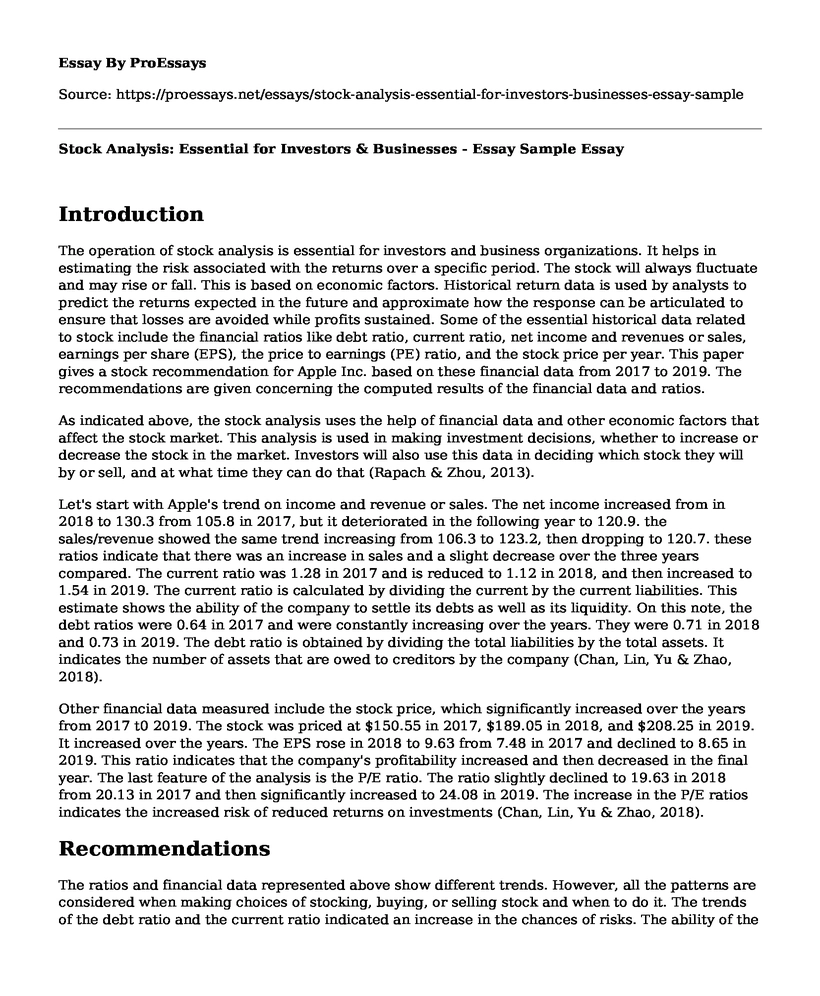Introduction
The operation of stock analysis is essential for investors and business organizations. It helps in estimating the risk associated with the returns over a specific period. The stock will always fluctuate and may rise or fall. This is based on economic factors. Historical return data is used by analysts to predict the returns expected in the future and approximate how the response can be articulated to ensure that losses are avoided while profits sustained. Some of the essential historical data related to stock include the financial ratios like debt ratio, current ratio, net income and revenues or sales, earnings per share (EPS), the price to earnings (PE) ratio, and the stock price per year. This paper gives a stock recommendation for Apple Inc. based on these financial data from 2017 to 2019. The recommendations are given concerning the computed results of the financial data and ratios.
As indicated above, the stock analysis uses the help of financial data and other economic factors that affect the stock market. This analysis is used in making investment decisions, whether to increase or decrease the stock in the market. Investors will also use this data in deciding which stock they will by or sell, and at what time they can do that (Rapach & Zhou, 2013).
Let's start with Apple's trend on income and revenue or sales. The net income increased from in 2018 to 130.3 from 105.8 in 2017, but it deteriorated in the following year to 120.9. the sales/revenue showed the same trend increasing from 106.3 to 123.2, then dropping to 120.7. these ratios indicate that there was an increase in sales and a slight decrease over the three years compared. The current ratio was 1.28 in 2017 and is reduced to 1.12 in 2018, and then increased to 1.54 in 2019. The current ratio is calculated by dividing the current by the current liabilities. This estimate shows the ability of the company to settle its debts as well as its liquidity. On this note, the debt ratios were 0.64 in 2017 and were constantly increasing over the years. They were 0.71 in 2018 and 0.73 in 2019. The debt ratio is obtained by dividing the total liabilities by the total assets. It indicates the number of assets that are owed to creditors by the company (Chan, Lin, Yu & Zhao, 2018).
Other financial data measured include the stock price, which significantly increased over the years from 2017 t0 2019. The stock was priced at $150.55 in 2017, $189.05 in 2018, and $208.25 in 2019. It increased over the years. The EPS rose in 2018 to 9.63 from 7.48 in 2017 and declined to 8.65 in 2019. This ratio indicates that the company's profitability increased and then decreased in the final year. The last feature of the analysis is the P/E ratio. The ratio slightly declined to 19.63 in 2018 from 20.13 in 2017 and then significantly increased to 24.08 in 2019. The increase in the P/E ratios indicates the increased risk of reduced returns on investments (Chan, Lin, Yu & Zhao, 2018).
Recommendations
The ratios and financial data represented above show different trends. However, all the patterns are considered when making choices of stocking, buying, or selling stock and when to do it. The trends of the debt ratio and the current ratio indicated an increase in the chances of risks. The ability of the company to pay its creditors is declining. Therefore, it would be essential if investors consider selling their stock and reducing investment (Chan, Lin, Yu & Zhao, 2018). the increase in the price value of the stock compared to the reduced sales and income in the final year indicate the risk of making losses. The trends in the other financial ratios and data also mean increased risk. Therefore, the stock should be reduced to a level that is sustainable for the company (Chan, Lin, Yu & Zhao, 2018).
References
Chan, J., Lin, S., Yu, Y., & Zhao, W. (2018). Analysts' stock ownership and stock recommendations. Journal of Accounting and Economics, 66(2-3), 476-498. https://doi.org/10.1016/j.jacceco.2018.08.010
Rapach, D., & Zhou, G. (2013). Forecasting stock returns. In Handbook of economic forecasting (Vol. 2, pp. 328-383). Elsevier. https://doi.org/10.1016/B978-0-444-53683-9.00006-2
Cite this page
Stock Analysis: Essential for Investors & Businesses - Essay Sample. (2023, Jul 05). Retrieved from https://proessays.net/essays/stock-analysis-essential-for-investors-businesses-essay-sample
If you are the original author of this essay and no longer wish to have it published on the ProEssays website, please click below to request its removal:
- The Legal Framework of International Investment Protection
- Forced Labour Essay Example
- Questions and Answers on Preferred Stocks Paper Example
- Management Discussion and Analysis Paper Example
- T-Mobile Financial Statement Analysis
- Financial Report Analysis of Ma'aden Paper Example
- Tech Transforming Financial & Banking: Secure Payments, Efficiency & Quality - Essay Sample







